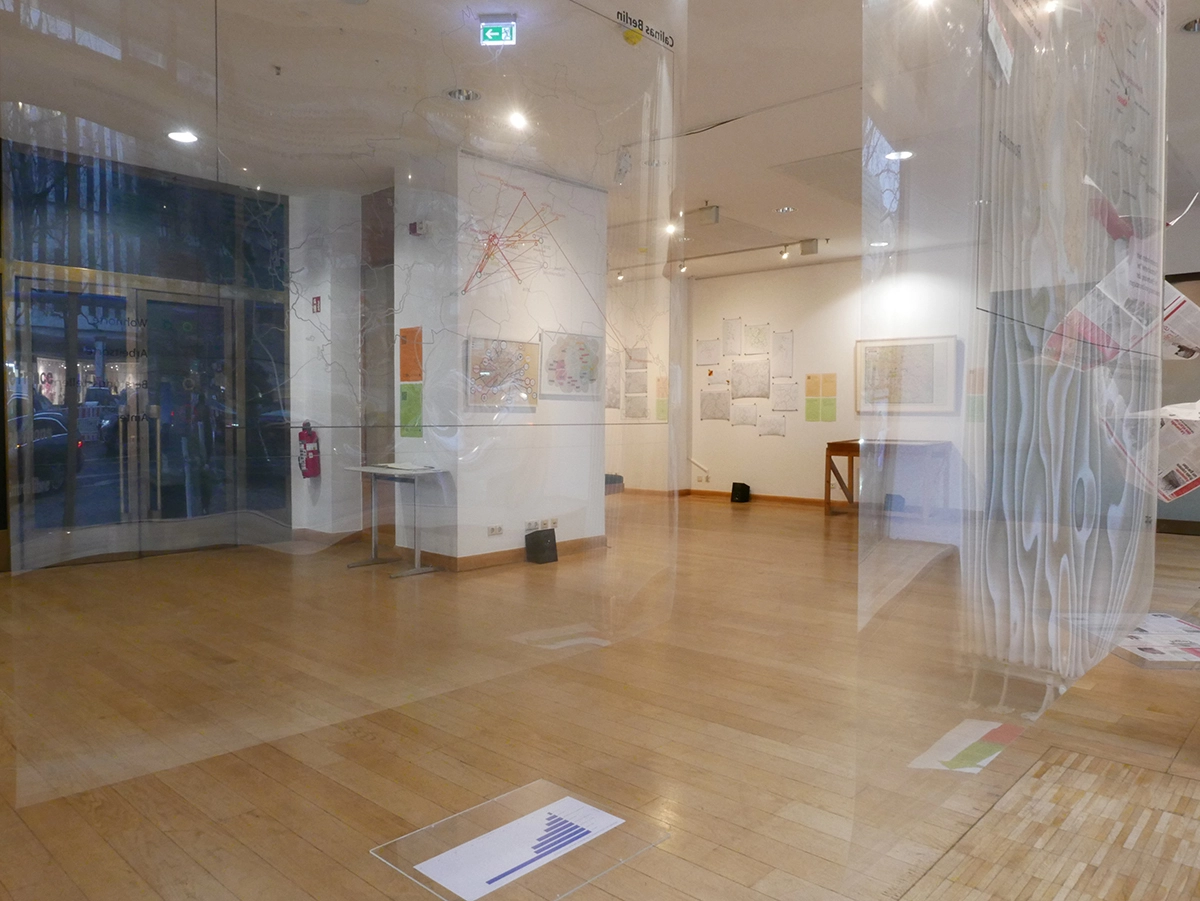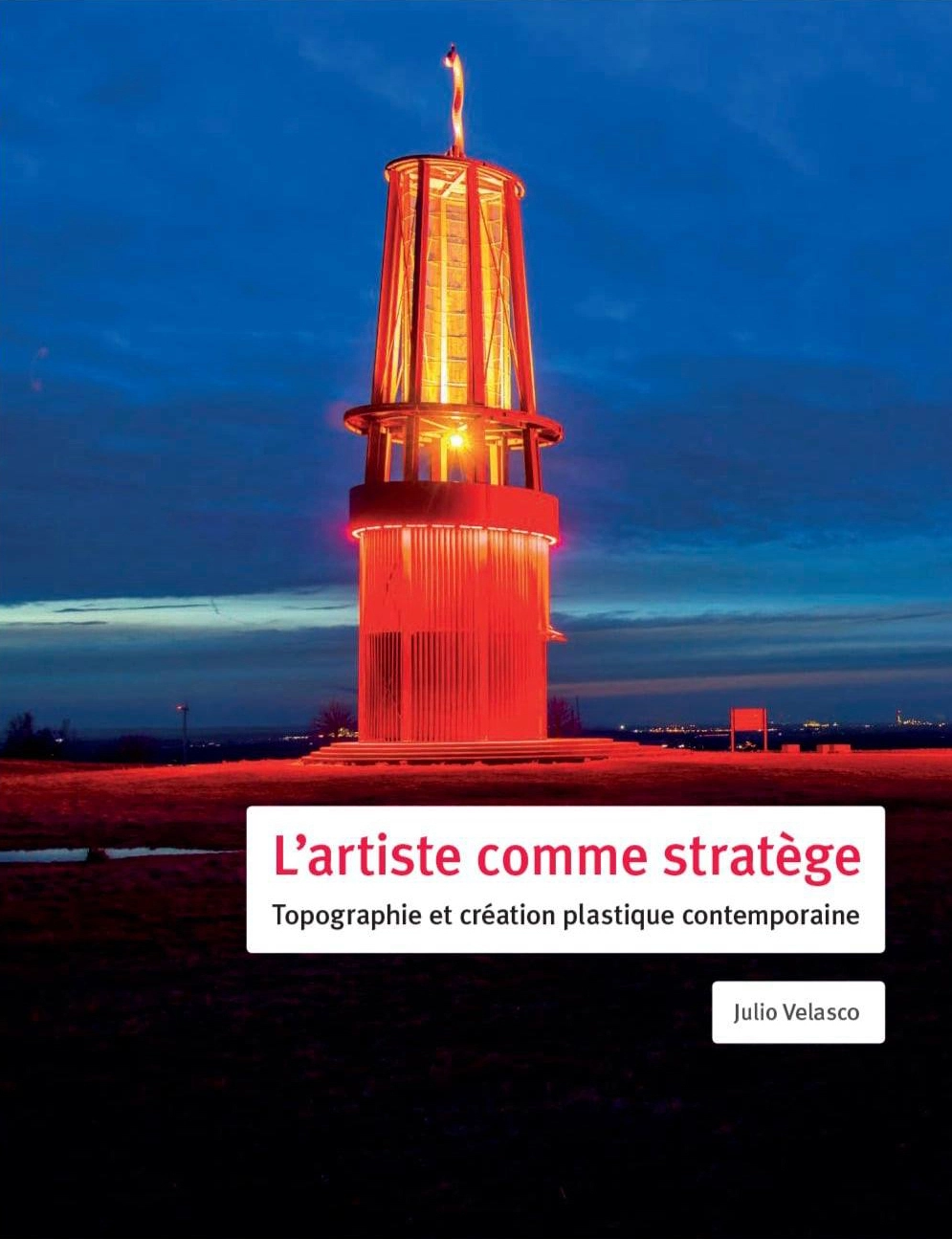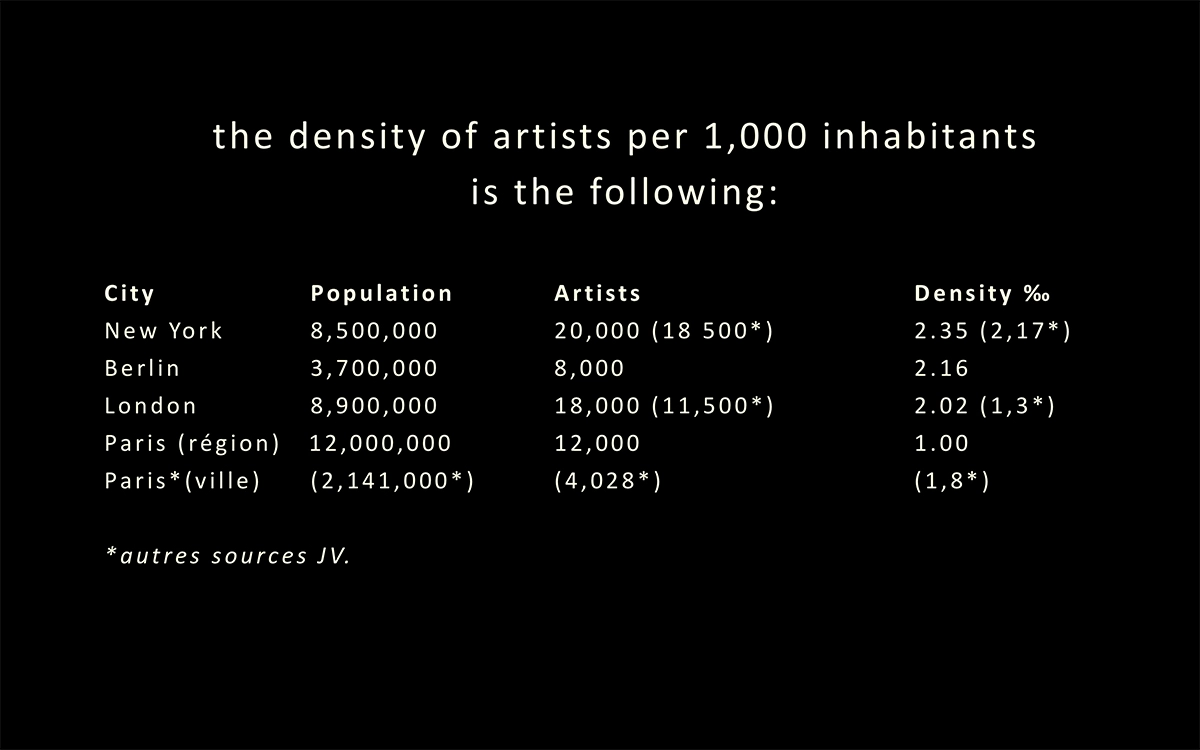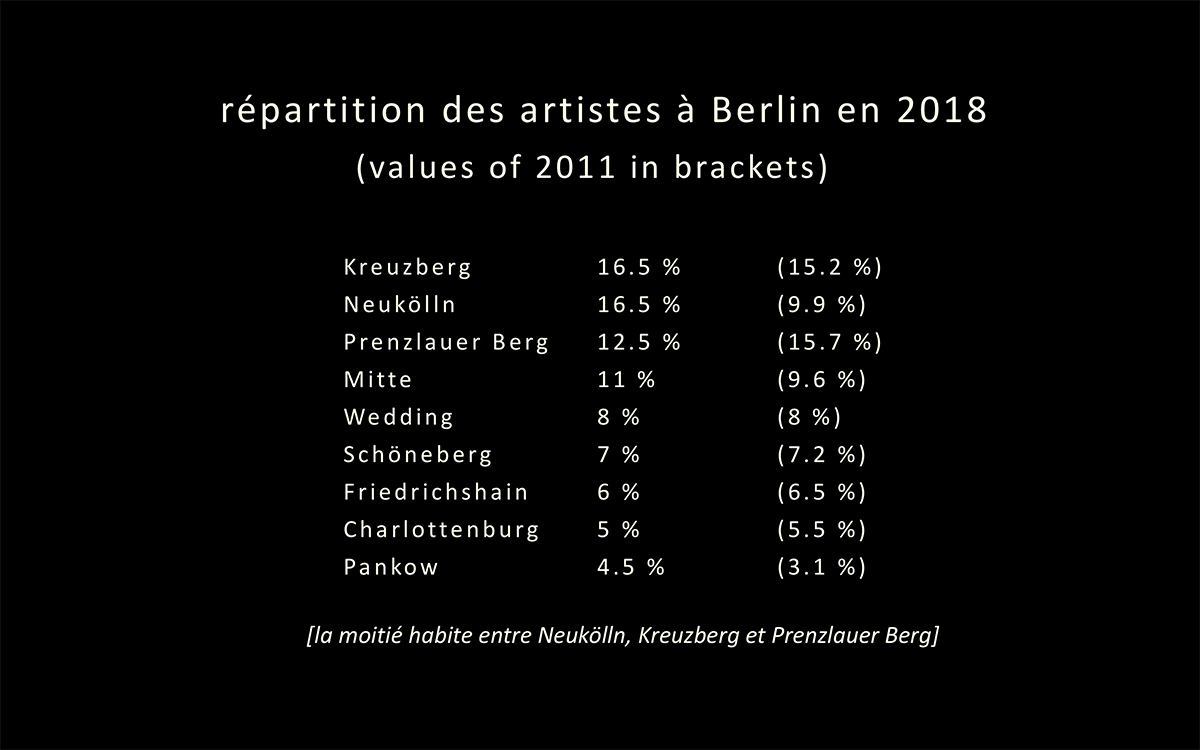City & Art
This section is dedicated to exploring the role of artists' gathering places in shaping artistic practices. Berlin, known for its reputation as a central hub for artists, is naturally one of the focus points for this exploration, but it extends to the broader concept of artistic districts, sites where artists come together and create. These areas reflect the diversities of the artists themselves, of their cultural and social origins and also of their productions, establishing a link between these diverse elements and making the topography of art a tool for studying artistic creation, its various evolutions and, above all, its processes.
Exhibitions and Installations
Les voi.es.x de la carte: Tonkörper Berlin

Institut français de Berlin, Berlin, Germany - 10 January - 22 February 2023 -
Curators: Julio Velasco and Marion Picker
The exhibition/installation "Les voi.es.x de la carte. Tonkörper Berlin" presented fourteen research projects in the humanities and social sciences related to the city of Berlin. These projects were showcased through cartographic works, recordings of interviews, reflections, poems, and urban sounds. Together, these elements formed a cohesive sound sculpture, creating a sensitive and immersive installation.
Project Description: "Les voi.es.x de la carte" is both an exhibition and an installation that seeks to bridge the gap between Art and the Humanities and Social Sciences by bringing together projects related to the city of Berlin. These projects were either completed or are ongoing, and they were carried out by PhD students and experienced researchers. The installation draws inspiration from the conceptual artists like Sol LeWitt, particularly his series Walldrawing, where the creation process is defined by an initial artist and can then be executed by another artist or "intervenant," following a set of instructions similar to a musical score.
The project applies this principle to visual arts, allowing each participating project to maintain its own identity while integrating into a broader, more complex whole. This creates a structural link between the individual and the collective without compromising the essence of either. The exhibition ultimately blurs the lines between author and artwork, emphasizing the collaborative and dynamic nature of artistic creation.
Works presented in the exhibition: Petra Beck, Was die Toten hören. Ce que les morts entendent; Sanja Beronja, Les start-up à Berlin; Raluca Enescu, with Antonis Anissegos and Andreas Karaoulanis, L’Ombre d’un Doute: Sciences forensiques et erreurs judiciaires; Moritz Gansen, with Camila Caux and Eric Macedo, An Ash (10/271) / Eine Esche (10/271) / Un Frêne (10/271); Nazan Maksudyan, Des orphelins ottomans à Berlin, 1917; Anati Méjanès, Les quartiers « péricentraux » à Berlin, le devenir-métropole; Telmo Menezes and Camille Roth, Les frontières selon Instagram; Ophélie Mercier, AL.Map: Fragments de terrain de recherche parmi les artistes arabes; Frank Müller, Walter Benjamin et la gare d’Anhalt; Coline Rousteau, Le Bundesamt für Migration und Flüchtlinge, antenne de Berlin; Pascal Charles Schneider, Récits d’une topographie fantôme; Denis Thouard and Marion Picker, Un ensemble berlinois; Nikola Tietze, Des citoyennes européennes berlinoises dans les jeux d’échelles de l’Union européenne; Sébastien Vannier, « Berlin Laboratoire d’Innovations » : les avenirs du passé.
It is planned that the exhibition will be presented again in 2025, possibly in January. Detailed information on the website of the exhibition.
Publications
L'artiste comme stratège.
Topographie et création plastique contemporaine
Author: Julio Velasco
Publisher: CTHS Editions, Paris, 2021

Based on a transdisciplinary investigation, this book examines art territories through the lens of their relationships with artistic production and the transformations they foster within it. After a historical study dedicated to this type of places, six contemporary art territories in five different cities are analyzed. The author then explores the visual or theoretical work of seven leading figures in contemporary art, who lived in the Faubourg Saint-Denis district of Paris in the 21st century. Comparisons between the various neighborhoods and the group of art personalities highlight elements of a collective strategy and identify common characteristics among them. The fundamental role played by these territories in the formation of an artistic identity and in the construction of the autonomy of the contemporary art field is thus illuminated.
Table of contents here. More information on publisher's website.
ArticleLes voi.es.x de la carte / Tonkörper Berlin
Journal: Cahiers des Umifre, 2023-2024, n° 10 (pp. 17-20), January 2024.
Authors: Julio Velasco and Marion Picker
This article reports on the exhibition *Les voi.es.x de la carte* held at the Galerie Alice Guy of the Institut français de Berlin. The article highlights the collaborative nature of the project, where artists and researchers challenge the traditional boundaries and characteristics of their respective fields, such as individuality and subjectivity in art, and objectivity and rationality in the sciences. The article also poses questions about the conditions that allow for the recognition of participation in an artistic creation as scientific, or vice versa, in a scientific investigation.
Read the full article on the Cahiers des Umifre website.
ArticleBerlin comme territoire d'Art (Forthcoming)
Expected Publication Date: 2025

© Julio Velasco
This forthcoming article will present the findings of a postdoctoral research project focused on the art districts in Berlin, exploring their causes, consequences, and evolution since the reunification of Germany. The research seeks to provide a nuanced understanding of these artistic territories, examining not only their impact on surrounding neighborhoods, such as gentrification, but also their significant influence on visual creation itself. While previous studies have often justified the existence of these artistic groupings on practical grounds, such as low real estate prices, this work highlights the symbolic functions and artistic implications of these gatherings.
The research also incorporates a comprehensive analysis of data from the KSK (Künstlersozialkasse) and BBK (Berufsverband Bildender Künstler*innen Berlin), spanning the years 2007 to 2021. This allows for objective comparisons across different periods and regions in Germany, shedding light on the evolving nature of Berlin's art scene. Additionally, the article will address the limitations of existing sources, emphasizing the need for a more holistic approach to understanding the dynamics of art districts.
ArticleL’image des artistes et des acteurs de l’art contemporain à travers leurs quartiers
In: Art et territoire Quartiers d'artistes : l'art comme outil de transformation du territoire, Editions de la Sorbonne, Paris, 2018
Texts from the symposium: Art collaboratif et territoire, Colloque international, Amphithéâtre Lefebvre, Université de la Sorbonne, 2014
This article explores the dominant characteristics of the identity that the art world seeks to convey and the self-image of this group by examining a contemporary art neighborhood in Paris and comparing it to the historic art district of Montmartre at the turn of the 19th to 20th century.
The study begins by defining the components of "artistic places" and "people of art." It then presents the Faubourg Saint-Denis district—a lesser-known art neighborhood in Paris, rich in contemporary visual creators—before addressing key aspects of the Montmartre art district. Finally, it establishes a typology of art neighborhoods and discusses the collective identity that this typology produces, concluding with hypotheses drawn from this comparative analysis.
ArticleArt et gentrification
In: Les acteurs de la composition urbaine Actes du congrès de Tours 2012, Paris, 2014
In a now-famous article, R. Deutsche and C. Gendel Ryan demonstrate how the transformation of New York's East Village into an artists' district in the 1980s was deeply connected to the displacement of the working-class population, making way for Wall Street employees. In Paris, during the first decade of the 21st century, a significant number of contemporary art figures settled around the Faubourg Saint-Denis in the 10th arrondissement. During the same period, this arrondissement experienced the highest real estate price increase in France.
This case might seem to confirm the widely accepted link between the gentrification of working-class neighborhoods and the artistic milieu. However, the study of the Faubourg Saint-Denis reveals significant typological and topographical shifts, highlighting the evolving relationships between art, society, and urban environments. Access the article
Symposium
Esthétique urbaine / Urban Aesthetologist
Centre Marc Bloch, Berlin & Institute of Architecture at Technische Universität Berlin, 9-10 February 2023
Organizers: Centre Marc Bloch, Institute of Architecture at Technische Universität Berlin, Architectural Humanities, DA, Università di Bologna.

Julio Velasco presented his research titled Berlin comme territoire d’Art during this interdisciplinary colloquium, which explored the aesthetic dimensions of urban environments. His presentation was a part of a larger discussion on the role of art in urban spaces, specifically focusing on Berlin’s unique status as a hub for artistic communities since the reunification of Germany.
Velasco's presentation provided an in-depth analysis of Berlin as an artistic territory post-reunification, examining the causes and consequences of the development of art districts in the city. He discussed the evolution of these districts, their impact on artistic creation, and the complexities of gentrification. The presentation highlighted the symbolic significance of these art districts beyond their practical functions, challenging conventional narratives around the influence of real estate prices on artistic communities. Velasco also touched upon the demographic shifts within Berlin's artistic population, noting the increasing professionalization and stability of these communities.
Key Points:
- Artistic Districts: Analysis of the historical and financial factors that shaped Berlin's art districts.
- Symbolic Significance: Discussion on the symbolic function of artistic gatherings in Berlin, challenging the notion that low real estate prices are the primary draw for artists.
- Gentrification: Examination of the nuanced relationship between art and gentrification in Berlin, contrasting it with other global cities.
- Demographic Shifts: Observations on the professionalization of Berlin's artistic community and the shift away from the bohemian image typically associated with the city.
Workshop
Configuration du territoire par l'art: Approches et méthodes
Dates: 9 January 2018 (Berlin) and 14 May 2018 (Paris)
Organizers: Julio Velasco, Centre Marc Bloch, Berlin; Université Paris 1 Panthéon-Sorbonne
The workshop titled "Configuration du territoire par l'art: Approches et méthodes" was a transdisciplinary event focusing on the relationship between art and urban spaces. It was held in two sessions: the first in Berlin at the Centre Marc Bloch on January 9, 2018, and the second in Paris at the Université Paris 1 Panthéon-Sorbonne on May 14, 2018. The workshop followed the "Arts et sciences humaines" initiative started by Pascal Dubourg-Glatigny in 2017.
During the Berlin session, the morning discussions were led by Boris Grésillon (Aix-Marseille University), featuring presentations by scholars and artists on topics such as the governance of art in the post-digital era and the experiences of Spanish visual arts professionals in Berlin. The afternoon session, chaired by Olga Kisseleva (Université Paris 1), included discussions on the integration of art in gated communities and the role of art districts as identifiers of contemporary artistic scenes, presented by Julio Velasco.
The Paris session focused on the strategic links between art and urban territories. Participants explored how cities become tools or objects for artistic work, and how various urban actors utilize art in the development of urban spaces. Key presentations included discussions on street art's role in urban valorization and the implications of large cultural events on artistic strategies, particularly during the Marseille-Provence 2013 event.
PhD L'artiste comme stratège.
La topographie dans la création plastique à Paris au début du XXIe siècle
Author: Julio Velasco
Université de Paris 1, Panthéon-Sorbonne
UFR Arts et Sciences de l'art
Amphithéâtre Liard, 17 rue de la Sorbonne, 75005 Paris - 3 July 2018
This thesis explores the relationship between territoriality and strategy in contemporary art. It examines the causes and consequences of artist gatherings, commonly known as "art districts" or "artist neighborhoods," for artistic creation. The originality of this work lies in its focus on these places through their impact on art itself and the transformations they foster within visual creation.
The research is structured into four parts:
- Part 1: Defines key terms such as "strategy" and categorizes art districts by their use—creation, exhibition, and habitation.
- Part 2: Analyzes six contemporary art districts and provides a historical overview of such places.
- Part 3: Examines the work of seven contemporary art figures from the Faubourg Saint-Denis neighborhood in Paris.
- Part 4: Connects theoretical research with personal artistic practice and proposes strategic insights.
A 9-minute video work, Lieux communs et double langage, accompanies this research work. Three different narratives are superimposed, each using a different medium: visual, sound or text. The Faubourg Saint Denis district of Paris forms the focal point of the whole. The video highlights the polysemic complexity of the quarter and the art world's contradictory relationship with it. In this way, the sound medium - an interview with one of the art world's characters living in the district - seems to be completely discordant with the other everyday elements that can be found in this territory.
Watch the video on Vimeo